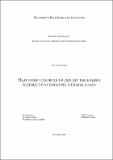Por favor, use este identificador para citar o enlazar a este item:
http://hdl.handle.net/10261/235591COMPARTIR / EXPORTAR:
 SHARE
BASE SHARE
BASE
|
|
| Visualizar otros formatos: MARC | Dublin Core | RDF | ORE | MODS | METS | DIDL | DATACITE | |

| Título: | Heat pump controls to exploit the energy flexibility of building thermal loads |
Autor: | Péan, Thibault | Director: | Costa Castelló, Ramon CSIC ORCID | Palabras clave: | Heat pumps Model predictive control Building model Rule-based control Energy flexibility HVAC control Smart grid Mixed-integer MPC formulation Energy-flexible building |
Fecha de publicación: | 24-ene-2020 | Editor: | Universidad Politécnica de Cataluña CSIC-UPC - Instituto de Robótica e Informática Industrial (IRII) |
Resumen: | Urgent actions are required to mitigate climate change and global warming. Decarbonizing our energy systems represents an important step in that direction. For the power grid, this means integrating larger share of renewable sources (RES), such as solar and wind power. Due to their variability and unpredictability, these sources however pose some challenges to the grid if they constitute the main electricity supply: possible supply-demand mismatch, consequent necessity to curtail RES production or to use peak fossil-fueled plants, grid congestions due to prosumers and decentralization, inviability of the other peak power plants without subsidies. Demand-side management (DSM), which consists in increasing the flexibility of the demand-side, constitutes a promising set of solutions to help manage the operation of the grid with high shares of RES. In particular, buildings and their embedded thermal mass can be regarded as thermal storage, and heat pumps represent one of the most ideal means to couple such storage with the power grid and cover the heating, cooling and hot water loads in a more flexible manner. Smart controls for heat pumps are required to harness the full energy flexibility potential of building thermal loads. A thorough literature review revealed that most strategies used for this purpose can be classified in two categories: rule-based control (RBC) and model predictive control (MPC). RBC is made of simple rules of the form ”if a condition is verified, then take an action”. MPC is a more advanced strategy that makes use of models and forecasts the behaviour of the systems in the near future in order to find the optimal plan of action. It requires the prior development of models, and the solving of an optimization problem at regular time intervals. For this reason, its development and operating costs are higher, although it outperforms RBC strategies in most cases. Both RBC and MPC can use external signals (named penalty signals in this thesis) to prompt their actions. The price of electricity is most often used for this purpose, leading to strategies that aim to reduce the costs. It was suggested to use also other signals, for this purpose a CO2 emissions signals was developed and used. This signal was derived from a new methodology presented in this work, and represents the marginal emissions of the grid (MEF): it thus gives a more accurate estimation of the potential impacts of DSM actions in terms of carbon footprint. In the mark of this thesis, both an RBC and an MPC controllers were developed as supervisory controls for an air-to-water heat pump supplying the heating, cooling and hot water needs of a residential building. The RBC strategy consists in modulating the set-points in the indoor space and in a hot water tank, using the penalty signal as trigger for the modulation. The MPC strategy consists in minimizing the overall summed penalties due to the heat pump use, while balancing with comfort constraints and a proper operation of the systems. Two versions of these controllers were produced: one using the electricity price as penalty signal, the other using the marginal emissions. The MPC controller in particular required the development of a simplified model of the building envelope (resistance-capacitance grey-box model) and of the heat pump performance, both adjusted differently for heating or cooling operation. The MPC included several novelties in its configuration, such as the mixed-integer formulation, the heat pump simplified model based on experimental data and the consideration of its computational delay. | Descripción: | Tesis llevada a cabo para conseguir el grado de Doctor por la Universidad Politécnica de Cataluña.--2020-01-24 | Versión del editor: | https://futur.upc.edu/26717494 | URI: | http://hdl.handle.net/10261/235591 |
| Aparece en las colecciones: | (IRII) Tesis |
Ficheros en este ítem:
| Fichero | Descripción | Tamaño | Formato | |
|---|---|---|---|---|
| TTQP1de1.pdf | 5,06 MB | Adobe PDF |  Visualizar/Abrir |
CORE Recommender
Page view(s)
106
checked on 23-abr-2024
Download(s)
699
checked on 23-abr-2024
Google ScholarTM
Check
NOTA: Los ítems de Digital.CSIC están protegidos por copyright, con todos los derechos reservados, a menos que se indique lo contrario.
